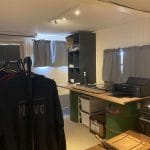Three schoolboys used Lockdown to launch a clothes-printing business. Quinn Porter, 16, explains how he and Hereford Cathedral school friends, Jake banks and Freddy Jones, wrestled with very grown-up challenges
It was during a global pandemic with a recession imminent that we decided to start a business. Besides, schools had closed so the one thing we had was time.
There were three of us; long-time friends, even though an unlikely group, given our different interests and backgrounds. But the one thing we shared was a love for business.
It all started in 2018 when we started our first company through the Young Enterprise charity, and since then any excuse to start another would do.
I sat down at home, locked inside, with no exams pending and thought – there’s an opportunity here. Instantly, I went to the guys with an idea for a clothing brand. We knew how hard the fashion Industry was, but they were determined to make it work, and so it began.
I am the Marketing Director. I love the social subjects such as English and languages. Jake works on a math-science axis and so, naturally, he assumed the role of CFO, and Freddie is very practical and imaginative, and so he became operations director.
The novelty of starting a business was diminished by countless pages of technical and legal terms
What followed were daily video chats and online research. We would chat for hours, coming up with designs and ideas, bouncing ideas off each other as our phones slowly died, and our heads began to drop.
We discussed all kinds of design ideas; everything from split T-shirts to tie dye. It took even more hours of debate to agree on the smallest details and so it was a difficult process.

We would Zoom and Facetime several times a day, trying to agree on names, designs, and suppliers. Names such as Guru, Edge, and Ultima were thrown around but were constantly vetoed! It was only after hours of research that we finally agreed on Nova. We also had to do market research, and being teenagers, we knew nothing about the law or how the industry worked, so we had to find out for ourselves; spending whole days on our computers, researching everything we could. The novelty of starting a business was diminished by countless pages of technical and legal terms, but nevertheless, after countless Google searches and tutorials we began to gain a rudimentary understanding of the law.
It dawned on us just how difficult this task was! We read up on the success stories of others and got in touch with some other small clothing brands such as Aspect Apparel.
But throughout it all, the same barrier kept emerging – who, in their right mind, was going to trust a bunch of 16-year-olds with their hard-earned money?
So, I set out to find exactly that person. I spent hours researching investment pitch decks, and after days of trying, my work ethic gave out once again. I scouted the internet for ages to find a potential business mentor, and even messaged all of my contacts but to no avail, until I found a site called micromentor that connected me with Shards, a business mentor from company 2Whyn, who took me on for free!
The next few weeks were filled with meetings over the phone, where Shards walked me through each step of the fashion Industry, including virtual fashion shows, how to design neck tags and how to innovate within a highly competitive industry.
We bought our heat press on ebay, and we marveled at how professional it looked. But as we were pressing our first shirt, it literally blew up
She also taught me how to make a pitch deck and design investment packages, and within the month, we had the first £1,000 we needed to start up our small operation, gaining investment from other small business owners.
Shards also gave me lots of useful advice such as the importance of buying ethically and taking our time to launch. As eager as I was to rush into it, I realised that we had to take our time, and prepare.
We all agreed that the business should be run ethically, and so we found ethical suppliers that we could trace back to WRAP-certified factories and ordered our products. We bought our first stock from Nottingham wholesale supplier Wordans, and we opted to heat-press vinyl on to our clothes, as it was the quickest and simplest method.
We set up a production line in Freddie’s shed and got to work. We got old boxes and shelves, and with the help of a pressure washer, paint, and hard labour, managed to form a production line. We had to wear masks the whole time, too. We decided to start by pressing our logo, that we agreed upon after further hours of discussion.
We bought our heat press on ebay, and we marvelled at how professional it looked. But as we were pressing our first shirt, it literally blew up. We sat there staring at our piece of equipment as smoke began to rise, and we could not help but break down in nervous laughter.
It took six hours of calling and being put on hold, eight emails, and a lengthy twitter feud until we got the refund
That experience taught us never to buy cheap! £100 for a heat press was too good to be true. We had wasted our first investment, and conscious about how little we had in the bank, we began to realise that this wasn’t going to be east, but we didn’t give up.
CFO Jake took the bullet and wrestled with customer services for hours. It took a total of six hours of calling and being put on hold, eight emails, and a lengthy twitter feud until we got the refund we needed.
That was when we decided to screen print. We found that screen printing looked much better and started the production process all over again, slightly embarrassed, but still very excited.
We ordered in a custom-made silk screen, that cost us £75, and looked very professional. We started to print our shirts, and it was to our great anger that Freddie decided to take a scrub brush to our new screen, which was now heavily punctured, and we had to order more screens, and watch hours of tutorials on cleaning them.
Another rookie mistake left us embarrassed once again.
Finally, we found a new supplier for the screens – Hunt the Moon, in Yelverton, Devon, and after paying the £50 for our new screens, once again we began to print, this time making sure we were extremely delicate. The screens seemed like a bargain, and held up fairly well, and we finally had the start of our small brand.
Then, of course, we needed to sell them, and that is where my job really began.
PART TWO: Marketing on (very tiny) a budget


